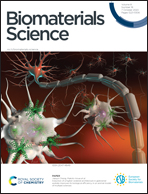Natural polysaccharide-incorporated hydroxyapatite as size-changeable, nuclear-targeted nanocarrier for efficient cancer therapy†
Abstract
Targeted delivery of anticancer drugs is one of the most promising methods for cancer therapy. However, barriers including complicated procedures, costly preparation, and toxic side effects have restricted the development of nuclear-targeted nanocarriers. Natural polysaccharides as extracellular matrix constituents or analogs play an important role in biomineralization. Herein, a simple, polysaccharide-intervened preparation of hydroxyapatite (HA) hybrid nanoparticles (NPs) with low crystallinity was used as a bio-safe carrier for targeting the delivery of doxorubicin (DOX) for efficient anticancer therapy. The poorly crystallized hybrid HA NPs were specifically taken up by cancer cells (HeLa cells), and subsequently, the abrupt degradation of HA nanoparticles would cause a change in the osmotic pressure, leading to the explosive death of cancer cells. Furthermore, the hybrid HA NPs were size changeable and capable of directly delivering the anti-cancer drug into the nucleus of cancer cells, thereby efficiently killing cancer cells. In addition, the HA/ALG NPs reduce the toxicity of DOX to L929 cells and cause little negative effect on normal tissue cells. The in vitro and in vivo experiments confirmed that the size-changeable HA-ALG/DOX could be a promising nuclear-targeted delivery nanocarrier for efficient cancer therapy.



 Please wait while we load your content...
Please wait while we load your content...